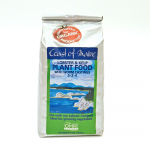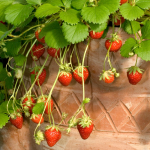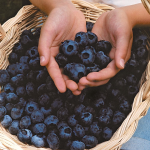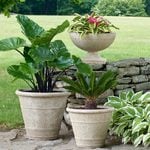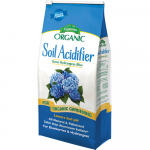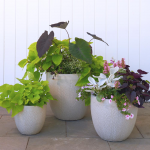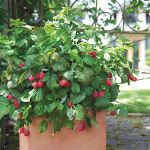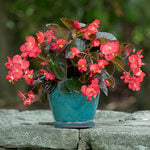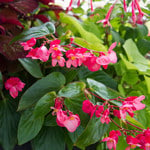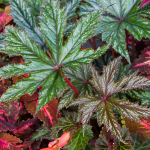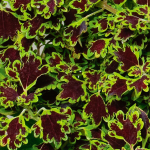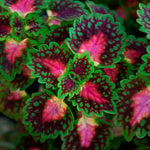Product Details
A colorful showstopper, Bushel and Berry® Peach Sorbet® is a stunning compact Blueberry bush, with new spring growth in shades of peach, pink, orange, and emerald. Its white, bell-shaped flowers in spring give way to an abundant summer crop of healthy, sweet fruit, followed by deep purple foliage in the fall. These versatile plants are equally attractive as a shorter hedge or in a decorative container on the patio. Although plants are self-pollinating, they tend to produce better harvests when grown with a different Blueberry variety to help with cross-pollination. 'F06-043' PP 23,325
Formerly known as BrazelBerries®, Bushel and Berry® self-pollinating varieties fare as well in containers as in the ground. The berries are anything but dwarf, and once the plants are established, they will fruit reliably for years.
Growing Bushel and Berry® in containers:
Bushel and Berry® bushes are dwarf plants that produce full-size fruit. They will produce some fruit in the first couple of years, but really hit their stride in the third year and beyond. Upon arrival, replant in a 12-16" container using a peat-based potting soil mix with pine bark. Place the container outdoors in full sun for the growing season. As your plant matures, you will likely need to put it in a 20-24" diameter container. Your plant will start producing more fruit in the second year.
Fertilizing. Bushel and Berry® Blueberries thrive in acid soil (pH of 4.5-5.5). Fertilize your plants with a slow-release fertilizer designed for acid-loving plants in spring and again in midsummer.
Pruning. In spring, prune out any dead branches. After harvest, prune out fruit-bearing branches, leaving new branches to fruit the following season.
Wintering over. In colder climates (Zone 5), you can overwinter plants in their containers by storing them in a sheltered, unheated area such as a garage or shed once the leaves drop in fall. Be certain the soil is moist when the plant is brought under cover, and water very sparingly during the winter. Once every 6 weeks is generally sufficient. The intent is for the plant to go as dormant as possible. In spring, bring them outside when temperatures remain above 25° and place in full sun.
In warmer climates where freeze-thaw cycles occur, store plants on a protected porch. Where freezing is not a concern, plants can remain outdoors in containers and enjoyed year round.
Growing Bushel and Berry® Blueberries in the ground:
Choose a planting location in full sun (at least 6 hours of direct sun each day) with soil that is moisture-retentive yet well drained. Because Blueberries grow best in soil that has an acid pH and is rich in humus, you should replace about half of the soil dug from the planting hole with at least as much peat moss. Mix the peat moss thoroughly into the remaining soil, and then dig a hole that will generously accommodate the plant's root ball.
Gently remove the plant from its pot and place into the hole so that the top of the root ball is level with the surrounding soil. Then push soil back into the hole around the plant and press firmly with your hands to eliminate air pockets and establish good soil contact. A gentle but thorough watering will further settle the soil around the plant.
Blueberries require about 1″ of rain or irrigation per week. Surrounding your plants with a 4–5′ circle of mulch helps keep the soil moist and prevents the growth of weeds. Apply a 2–4″ layer of wood chips, shredded bark, or other organic material. The year after planting (and every year thereafter) apply a fertilizer designed for acid-loving plants at flowering time in spring and again about 4 weeks later.
Shipping
HOW PLANTS ARE SHIPPED
The size of the plants we ship has been selected to reduce the shock of transplanting. For some, this means a large, bareroot crown. Others cannot travel bareroot or transplant best if grown in containers. We ship these perennials and annuals in 1 pint pots, except as noted. We must point out that many perennials will not bloom the first year after planting, but will the following year, amply rewarding your patience. We ship bulbs as dormant, bare bulbs, sometimes with some wood shavings or moss. Shrubs, Roses, vines, and other woody plants may be shipped bareroot or in pots. The size of the pot is noted in the quick facts for each item.
WHEN WE SHIP
We ship our bulbs and plants at the right time for planting in your area, except as noted, with orders dispatched on a first-come, first-served basis by climate zone. We also ship a wide range of containers and planters, tools, supplies, fertilizers, garden wear, garden decor items, as well as indoor decorations like wreaths and dried bouquets when available. Estimated dates for shipping are indicated in the green Shipping Details box for each item. Please supply a street address for delivery. Kindly contact us with two weeks notice, if you'll be away at the expected time of delivery.
OUR GUARANTEE
We guarantee to ship plants that are in prime condition for growing. If your order is damaged or fails to meet your expectations, we will cheerfully replace or refund it. Please contact our Customer Service Department at 1-800-503-9624 or email us at [email protected]. Please include your order number or customer number when contacting us.
Reviews
Average Customer Rating:
 (14 Reviews)
Write a Review
(14 Reviews)
Write a Review
Sort by:
update on last years plant 
A viewer from Windsor Locks, CT
very happy customer here.
5 of 5 people found this review helpful. Do you? yes no Certified buyer
Beautiful ornamental plant 
A viewer from Northern Virginia
7 of 7 people found this review helpful. Do you? yes no Certified buyer
Give it time 
A viewer from Windsor Locks, CT
these are great little plants!
10 of 10 people found this review helpful. Do you? yes no Certified buyer
Imperfect but good plant 
A viewer from Dayton, OH, USA
8 of 8 people found this review helpful. Do you? yes no Certified buyer
Brand Confusion? 
A viewer from Pittsburgh, PA
that it was from a third-party grower. I mistakenly believed that WFF grew their own plants, hence the generally good quality and the premium on price. This plant is the exact brand sold at the big box store near me. I hope it performs better, but not happy paying more for a product available down the street for less.
66 of 67 people found this review helpful. Do you? yes no Certified buyer
Growing guide
Growing Bushel and Berry® in containers:
Bushel and Berry® bushes are dwarf plants that produce full-size fruit. They will produce some fruit in the first couple of years, but really hit their stride in the third year and beyond. Upon arrival, replant in a 12-16" container using a peat-based potting soil mix with pine bark. Place the container outdoors in full sun for the growing season. As your plant matures, you will likely need to put it in a 20-24" diameter container. Your plant will start producing more fruit in the second year.
Fertilizing. Bushel and Berry® Blueberries thrive in acid soil (pH of 4.5-5.5). Fertilize your plants with a slow-release fertilizer designed for acid-loving plants in spring and again in midsummer.
Pruning. In spring, prune out any dead branches. After harvest, prune out fruit-bearing branches, leaving new branches to fruit the following season.
Wintering over. In colder climates (Zone 5), you can overwinter plants in their containers by storing them in a sheltered, unheated area such as a garage or shed once the leaves drop in fall. Be certain the soil is moist when the plant is brought under cover, and water very sparingly during the winter. Once every 6 weeks is generally sufficient. The intent is for the plant to go as dormant as possible. In spring, bring them outside when temperatures remain above 25° and place in full sun.
In warmer climates where freeze-thaw cycles occur, store plants on a protected porch. Where freezing is not a concern, plants can remain outdoors in containers and enjoyed year round.
Growing Bushel and Berry® Blueberries in the ground:
Choose a planting location in full sun (at least 6 hours of direct sun each day) with soil that is moisture-retentive yet well drained. Because Blueberries grow best in soil that has an acid pH and is rich in humus, you should replace about half of the soil dug from the planting hole with at least as much peat moss. Mix the peat moss thoroughly into the remaining soil, and then dig a hole that will generously accommodate the plant's root ball.
Gently remove the plant from its pot and place into the hole so that the top of the root ball is level with the surrounding soil. Then push soil back into the hole around the plant and press firmly with your hands to eliminate air pockets and establish good soil contact. A gentle but thorough watering will further settle the soil around the plant.
Blueberries require about 1″ of rain or irrigation per week. Surrounding your plants with a 4–5′ circle of mulch helps keep the soil moist and prevents the growth of weeds. Apply a 2–4″ layer of wood chips, shredded bark, or other organic material. The year after planting (and every year thereafter) apply a fertilizer designed for acid-loving plants at flowering time in spring and again about 4 weeks later.

